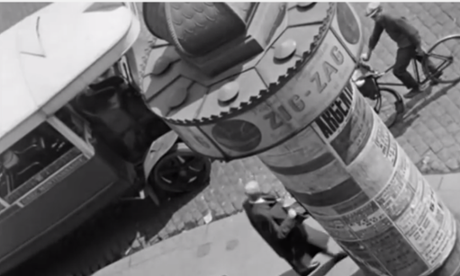
In the early 1920s, when the silent era of film-making was still in full swing, the genre of the city symphony emerged. Exactly what constitutes a city symphony is somewhat fluid, but broadly speaking it can be defined as a poetic, experimental documentary that presents a portrait of daily life within a city while attempting to capture something of the city’s spirit.
More specifically, the term refers to films that are influenced by the form and structure of a musical symphony, although it is debatable as to how many of the films labelled as city symphonies conform to this pattern. Indeed, the city symphony tag is so slippery that it’s questionable whether even its most famous example – Man with a Movie Camera (1929) – is a true city symphony.
Movie Camera is famous for presenting a dazzling portrayal of urban city life, but when considered as part of the genre, the film is a cheat: it was actually shot in three different Ukrainian cities (Odessa, Kharkiv and Kiev) so, while as a piece of film-making it is magnificent (it was recently voted the greatest documentary of all time by Sight & Sound), it is arguable that the film’s concoction of a Ukrainian super-city robs us of one of the greatest joys of the genre: that of seeing a specific city as it was.
When seen today, films like Études sur Paris (1928) and Berlin: Symphony of a Great City (1927) offer us fascinating glimpses not only of their eponymous cities, but also of the time in which they were made. As the decades pass, city symphonies only increase in interest, rising above their initial existence as breath-taking avant garde experiments to the level of vitally important cultural documents. This is even more the case with a film like Berlin, which holds increased poignancy given that much of the city was subsequently destroyed during the second world war.
Seen together, the Berlin and Paris films make for an interesting comparison. There’s an undeniable chain of influence among many of the city symphonies, and close study reveals similarities and differences of interest. For instance, both Berlin and Paris begin by travelling from the outskirts to the centre of their respective cities: Berlin with a masterful montage of a train hurtling towards the centre, Paris with a more leisurely trip on a barge. The question that arises, of course, is this: does the difference say more about the cities themselves, or about the individual aesthetics of the film-maker? Is Paris, in fact, a more leisurely city than Berlin?
Berlin also shares a structural similarity with Movie Camera, in that both films are ostensibly day-in-the-life portraits, traversing the time from dusk to dawn, and showing citizens at work and at play. In contrast to the movement with which Berlin and Paris begin, Movie Camera opens in an empty cinema in which a film within the film will soon play. The cinema opening provides a reflexive framework to which director Dziga Vertov and his unsung wife and editor, Yelizaveta Svilova, will return throughout (at one point we even see Svilova editing the film we are watching).
Indeed, the film begins with a declaration that it is “an experimentation in the cinematic communication of visual phenomena”, and it can therefore be seen as much as an attempt to redefine the language of cinema as to present a portrait of a city – and it is perhaps the form as much as the content that has led to its enduring popularity. Berlin is likewise inventive in form, perhaps no surprise given that its director, Walter Ruttmann, had a background not in documentaries but in the German avant garde.
It is the two main aspects of the city symphony – the historical importance and the playfulness of form – that make them so fresh and appealing, even after all these years. It is also these two elements that I will be attempting to capture in my own silent city symphony, London Symphony, which is currently crowdfunding. The film will be a poetic journey through the capital, with the aim of exploring and celebrating London’s huge diversity of culture and religion, while also creating an important record of the city as it stands today (the film will be shot in over 200 locations).
In a world dominated by commercial films, I feel it is important to keep the medium of cinema alive by making films of this kind because, however we wish to define city symphonies, they offer us vital and vivid records of life gone by.
Alex Barrett is an independent film-maker. London Symphony is currently crowdfunding at www.londonsymphfilm.com.
Berlin: Symphony of a Great City (screening September 28), Man with a Movie Camera (October 26) and Études sur Paris (November 19) are all being shown as part of the Barbican’s upcoming City Visions season.

